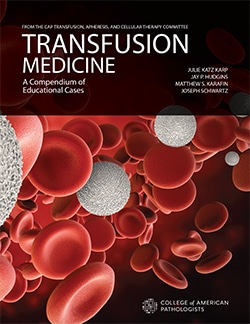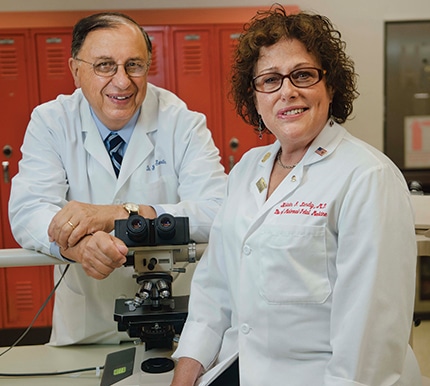March 2023—A retrospective study of patients who received blood transfusions at 15 community hospitals found that just over half of the patient encounters reviewed could have been managed without the transfusion of at least one component type, and 45 percent could have been managed without any transfusion.
Read More »The way forward for prehospital transfusion
December 2022—Ask Leonard Weiss, MD, what his favorite part of his schedule is, and he’s quick to answer that it’s the fieldwork: the helicopter and ambulance dispatches he accompanies once or twice a month as associate medical director of emergency medical services at the University of Pittsburgh Medical Center. Dr. Weiss, who is also assistant professor of emergency medicine and assistant medical director of Pittsburgh’s Stat Medevac service, says one of the UPMC emergency services he strongly supports is the prehospital transfusion of blood products. “Until recently, there wasn’t a lot of evidence to deploy its use on the ground as it is in the air, but thanks to extensive use by the military and scientific evidence of the value of prehospital transfusion,” he says, it is more likely to become part of some hospitals’ emergency medicine programs. The 911 ground-based transfusion program at UPMC and city of Pittsburgh EMS began in 2020. As Dr. Weiss and his UPMC colleagues acknowledge, however, myriad complexities come into play.
Read More »Platelet transfusions: safety, cost, and workflow
October 2022—The jury may no longer be out on whether pathogen reduction of platelet units reduces the risk of a septic transfusion reaction enough to replace culturing of platelet units.
Read More »As blood supply tightens, so too does mitigation
September 2022—Picture a performer juggling tenpins while walking a high wire, knowing that a hurricane looms. Add a safety net that could disappear at any time. That’s a sense of what hospital transfusion services experience in maintaining enough blood products to meet patients’ needs.
Read More »U.S. blood supply steadier but still short
August 2022—Blood is a precious resource and shouldn’t be treated as a commodity. That’s the consensus in the blood banking community, in line with a longstanding conviction that volunteer donations should remain at the blood system’s core. But as the worst of the pandemic appears to have passed, discussion of blood shortages has increasingly drawn on the vocabulary of commerce, and the warnings about the blood supply have been rife with references to supply chain problems that go beyond the need for more donations. Crises in the blood supply are nothing new, and while the health care system strives to stay prepared, the pandemic threw novel commercial and logistical factors into the mix, in some ways jumbling the expected order of a crisis for blood services. Hospitals scrambled to cope with a surge of COVID-19 patients while the spread of infection caused thousands of blood drives to be canceled, so there was a steep drop in supply of blood products, says Pampee Young, MD, PhD, chief medical officer, biomedical services, American Red Cross.
Read More »One hospital’s story: Ins and outs of low titer O whole blood use in trauma
July 2022—Myriad questions had to be answered and plans made to put low titer O whole blood in the trauma bay at Thomas Jefferson University Hospital. Julie Katz Karp, MD, associate professor and director of transfusion medicine, reported why, when, and how it was done and where they stand today, in a process she describes as “a never-ending series of hoops.”
Read More »Lining up for low titer O whole blood in trauma care
June 2022—For many blood suppliers, there is more enthusiasm for low titer O whole blood than there is an ability to make it, especially with the pandemic having made it harder than ever to collect.
Read More »In SARS-CoV-2, small steps but big wins
December 2020—By its very nature, the global pandemic has forced laboratories to look far and wide, to bring binoculars, in essence, to their views of supply chains, testing platforms, personnel, and the like. As COVID-19 churns on, some labs are looking through a tinier lens as well. These labs aren’t trading their binoculars for a jeweler’s loupe, exactly, but they have found small and significant success stories closer to home. Like so many others, Erin Graf, PhD, D(ABMM), has confronted a spinning roulette wheel since the pandemic’s start. In a talk she gave in an AMP webinar in October, Dr. Graf posted a vibrantly colored wheel titled, “Which supply chain issue will impact us this week?” Each segment contained a phrase familiar to everyone in 2020, ranging from “swabs” and “sheep blood agar” to “pipette tips” and “chlamydia and gonorrhea tests.” As she surveys these continuous claims on her attention, Dr. Graf says, “I think none of us could have ever thought that COVID would have an impact on all these arms of the testing that we do.”
Read More »What’s new in latest transfusion medicine checklist
September 2020—Strong quality management, patient safety, and conformity with regulations are at the heart of the new and revised requirements in the 2020 CAP accreditation program transfusion medicine checklist, released in June.
Read More »Transfusion cases out of cabinet, into new book
April 2020—CAP Publications released this month a new book titled Transfusion Medicine: A Compendium of Educational Cases, from the CAP Transfusion, Apheresis, and Cellular Therapy Committee. In it are 20 cases, each with a history, discussion, and questions and answers. Read more.
Read More »Activated or inactivated? Transfusing the right platelets
August 2019—In the blood bank, all platelets in bags appear to be the same, whether resting or activated, and because they look the same, they may be used as if they’re equal. But they are not.
Read More »Transfusion medicine checklist: Record and other requirements updated in new release
August 2018—One new requirement and several modified requirements in the CAP transfusion medicine checklist are part of the new edition of CAP accreditation program checklists released this month. In work led by the CAP Council on Accreditation, the checklists are examined anew and revised yearly, where needed. In transfusion medicine, the changes this year center on computer crossmatches, record retention, forward/reverse typing, and ABO group and Rh(D) type verification.
Read More »With hemolysis, tackling the rush with the reasoning
May 2018—First a journey. Then sometimes a vigorous shake. Little wonder that red blood cells hemolyze. “Red blood cells don’t like to be stressed,” says Kathleen Finnegan, MT(ASCP)SH, phlebotomy training program director at Stony Brook University School of Technology and Management, New York. She instructs her students to avoid stressing the RBCs by skipping what she calls the “martini shake” (CLSI recommends five to 10 tube inversions), using a needle that is the right size, and not using a syringe for transfer but instead a transfer device. “So it’s gentle,” she says.
Read More »AABB seeks comments on form to streamline transfusion adverse reaction reporting
January 2018—The AABB is seeking comments by March 30 on its common transfusion reaction reporting form, the seven pages of which are presented online at www.bit.ly/AABB-reportform. The fillable PDF form is intended to be used by hospitals and blood centers to communicate information about transfusion reactions to the blood supplier, particularly when there are multiple suppliers to the hospital transfusion service.
Read More »With diversion, lower blood culture contamination rates
July 2017—To stage magicians, diversion is a trick—a way to direct the audience’s attention to something irrelevant so they don’t notice what they shouldn’t see. To those who perform blood cultures, diversion is also a trick, though there’s nothing deceptive about it—and the way it helps avoid contamination can seem like magic.
Read More »New rays on blood safety
March 2017—The language of blood banking experts, as they talk about irradiators, transfers easily to a car dealership. How reliable are the newer models? Are you willing to replace it every 10 years or so? Do you keep running it until it dies? What parts are likely to burn out? What will repairs run? And then the word “terrorism” pops up.
Read More »Blood bank: On guard against daratumumab interference
October 2016—As fans of spycraft know, offensive counterintelligence can include an arsenal of strategies: initiating a diversion, sowing confusion, creating false identities—anything that makes another party believe something that isn’t true. If the cancer treatment drug daratumumab were capable of deceptive intent, it might be accused of all those ploys when it comes to interfering with blood transfusion crossmatching. The reason: For patients receiving daratumumab, marketed as Darzalex by Janssen Pharmaceuticals, antibody testing for transfusion is subject to erratic false-positives, often leaving transfusion services confused, uncertain, and on hold.
Read More »26 ‘hot seat’ cases in new transfusion medicine text
February 2016—Transfusion Medicine in the Hot Seat: A Case-Based Primer is a new book from CAP Press, due to be released next month. The editor, Karen Quillen, MD, MPH, and her five contributors wrote 26 cases grouped into three sections: Antibodies, Blood Components, and Complications.
Read More »Mislabeling, wrong-blood-in-tube errors rare but there
November 2015—Blood is thicker than water, the saying goes. And thanks to a recent Q‑Probes, the rates of mislabeled specimens submitted for ABO blood typing and of wrong-blood-in-tube errors are now as clear as water. The mislabeling rate hasn’t changed much since a similar Q‑Probes study was performed in 2007. The 2015 Q‑Probes, “Blood Bank Safety Practices,” reviewed 41,333 specimens and found that 306, or 0.74 percent, were mislabeled. The previous study looked at 112,112 specimens, of which 1,258, or 1.12 percent, were mislabeled.
Read More »Next step in blood use program: end-of-life transfusion
October 2015—To improve blood usage in 2011, Advocate Health Care in Illinois launched a systemwide blood management program, “7 is the new 10.” Within two years of its implementation, there was a notable decrease in annual red cell usage from 64,178 to 41,000 red cell units, with overall savings of $10 million.
Read More »Groups urge phase-in of RHD genotyping
October 2015—It may not be quite like boxing frogs or herding cats. But gaining broad consensus on a laboratory medicine practice can be difficult, especially where multiple organizations must agree. A new joint statement on RHD genotyping by the CAP and the AABB, plus four other organizations, shows that such consensus is possible, however, even where it involves a laboratory medicine practice in place for more than 50 years—especially when advances in molecular testing are offering a solution to a problem.
Read More »Massive transfusion: a question of timing, detail, a golden ratio
December 2014—Here it was, the kind of massive postpartum hemorrhage case for which the team at Duke University Medical Center had spent months preparing. The multidisciplinary group had agreed on which laboratory tests would be done in such a case, determined which blood products would be delivered, and decided which members of the OB team would be sent racing to retrieve the potentially life-saving package.
Read More »AABB ramps up donor screening to help stem TRALI
October 2014—When it comes to the blood supply, the tradeoffs between safety and availability are a tightrope that blood centers walk with extreme care. For several years now, TRALI (transfusion-related acute lung injury) has topped the list of causes of transfusion-related mortality in the U.S. Defined as acute lung injury that occurs during or within six hours of transfusion of a blood product, TRALI is fatal to six to 10 percent of the patients it strikes.
Read More »For safety and savings, lab takes on transfusions
July 2014—Hospitals are under fire to cut costs, and more often than not that means layoffs, forgoing new equipment, and watching from the sidelines as the medical literature touts advances that could help patients now—if only institutions could afford to implement them.
Read More »Tuning in to hypotensive transfusion reactions
April 2014—Most pathologists are trained to think of hypotensive transfusion reactions as rare events, and for the most part they are. But one pathologist’s experience suggests these reactions may be underreported, and perhaps on the rise. Greater recognition of these events could provide valuable information and help improve patient outcomes. “People often report these reactions as possibly related to transfusions, but the challenge to the pathologist is that the transfusion reaction workups are negative, for the most part. So they’re in a quandary as to whether the drop in blood pressure was because of the transfusion or other causes,” says Richard M. Scanlan, MD, clinical professor, vice chair of laboratory medicine, and director of the transfusion medicine service at Oregon Health and Science University (OHSU).
Read More »Poor testing, dosing dog fetomaternal bleeds
September 2013—If Mark Brecher, MD, were compiling a greatest hits list of medical successes of the 20th century, there’s one advance he’d be sure to include: the introduction of Rh immune globulin in the late 1960s to prevent the Rh sensitization of Rh-negative mothers who deliver an Rh-positive baby.
Read More »Challenge and change in blood bank systems marketplace
September 2013—From future innovations to tighter regulations, seven users and marketers of blood bank software shared their perspectives on the blood bank systems marketplace with CAP TODAY. Here and on the following pages is what they told us. Beginning on page 20 is the 2013 guide to blood bank information systems.
Read More »Policing blood use pays off for Allina Laboratories
March 2013—A January study of almost 1,000 patients with acute gastrointestinal bleeding has found that restrictive blood transfusion strategies produce better patient outcomes. The study, “Transfusion strategies for acute upper gastrointestinal bleeding,” discovered that patients with severe acute upper GI bleeding who received blood transfusions when their hemoglobin levels fell below 7 g/dL, rather than 9 g/dL, had higher probabilities of survival at six weeks, as well as reduced rates of further bleeding and fewer adverse events (Villanueva C, et al. N Engl J Med. 2013;368:11–21).
Read More » CAP TODAY Pathology/Laboratory Medicine/Laboratory Management
CAP TODAY Pathology/Laboratory Medicine/Laboratory Management


















